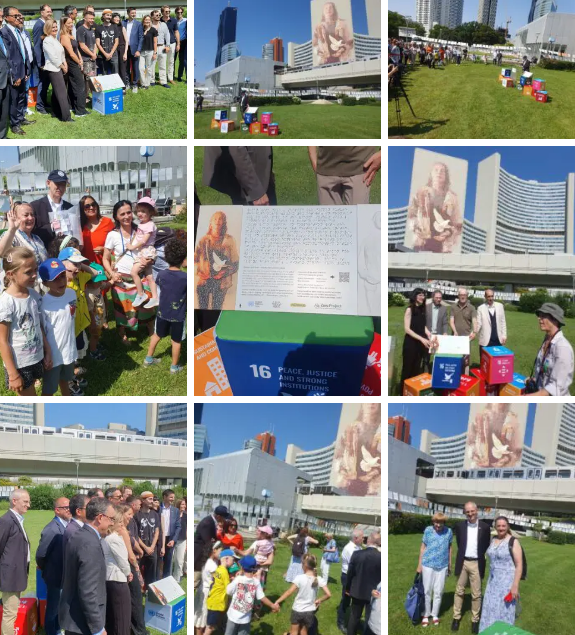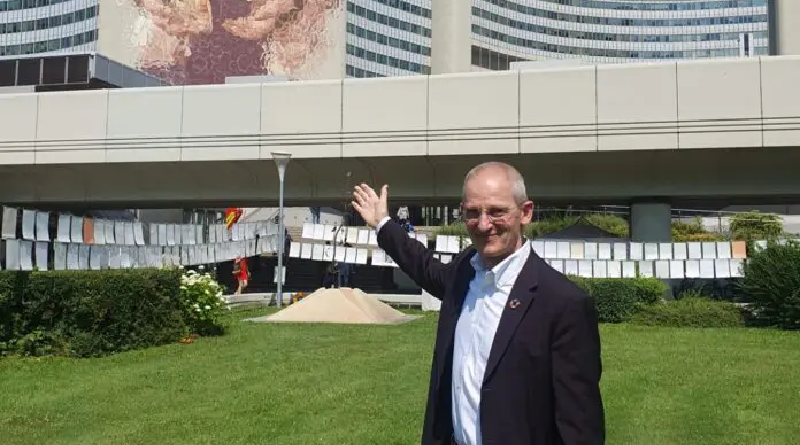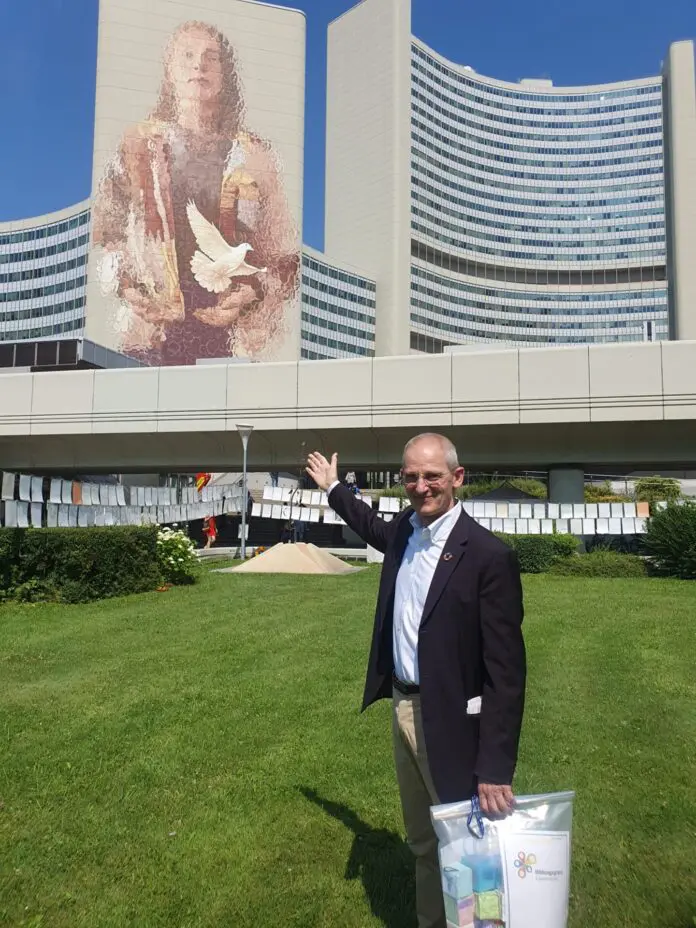Unveiling of Vienna’s Largest Mural: A Landmark Event for Art and Accessibility
Introduction to the Historic Event
On June 28, 2024, Vienna became the stage for a landmark event with the unveiling of its largest mural, an awe-inspiring artistic masterpiece. The grand ceremony was held at the Vienna International Centre, a venue that has long been a symbol of international cooperation and progress. Mr. Martin Nesirky, the esteemed President of the United Nations Information Service (UNIS), presided over the event, which drew representatives from a myriad of organizations, as well as the mural’s visionary artist. This monumental mural project is not just a celebration of artistic endeavor but also a profound statement of support for the Sustainable Development Goals (SDGs).
The mural’s unveiling coincided with the 45th anniversary of the Vienna International Centre’s inauguration, adding an extra layer of significance to the event. The Vienna International Centre, often referred to as the ‘UNO City,’ has been a hub for numerous international organizations and a beacon of global unity. The introduction of this expansive mural within its premises serves as a powerful visual representation of the Centre’s enduring commitment to fostering a sustainable and inclusive future.
The mural project, with its rich tapestry of colors and intricate designs, serves as a vibrant testament to the collaborative spirit that the SDGs promote. It stands as an inspiring example of how art can transcend boundaries and bring diverse communities together in pursuit of common goals. The presence of high-profile attendees, including Mr. Nesirky and other dignitaries, underscored the event’s importance and the shared commitment to the values embodied by the mural.
This historic event marks a significant moment in Vienna’s cultural and social landscape, symbolizing a harmonious blend of art, sustainability, and international cooperation. As the largest mural in Vienna, it is poised to become an enduring landmark, inspiring future generations and reminding them of the pivotal role that art plays in advocating for a more equitable and sustainable world.
Participants and Key Figures
The unveiling of Vienna’s largest mural was graced by a plethora of dignitaries and organizations, underscoring the event’s significance in the realms of art and accessibility. Representing the host country, Austria, prominent figures from the national government were present, alongside key officials from the city of Vienna and the 22nd district. Their collective presence highlighted the importance of this cultural landmark in fostering communal and artistic spirit.
The event also saw the active participation of representatives from the United Nations, reflecting the mural’s global resonance. High-ranking officials from major UN organizations based in Vienna, including the United Nations Office at Vienna (UNOV), the United Nations Office on Drugs and Crime (UNODC), the International Atomic Energy Agency (IAEA), the Comprehensive Nuclear-Test-Ban Treaty Organization (CTBTO), and the United Nations Industrial Development Organization (UNIDO), were in attendance. Their involvement underscored the mural’s embodiment of international cooperation and cultural exchange.
One of the focal points of the event was the presence of Fintan Magee, the acclaimed artist behind the mural. Magee’s work is known for its compelling narrative and social commentary, and this mural was no exception. His artistic vision, combined with the logistical support from the Calle Libre Street Art Festival, resulted in a breathtaking piece that is set to become a landmark in Vienna.
In a special mention, the Zero Project played a crucial role in ensuring that the mural is accessible to people with disabilities. This collaboration exemplifies the project’s commitment to creating an inclusive environment where art can be appreciated by all, regardless of physical limitations. The mural’s design incorporates features that make it more accessible, aligning with the Zero Project’s mission to improve the lives of people with disabilities worldwide.
Overall, the event was a testament to the collaborative efforts of local and international entities, community leaders, and artists, all striving towards a unified goal of enhancing cultural and social accessibility through art.
The Artistic Journey of Fintan Magee
The transformation of a tower at the Vienna International Centre into a vibrant mural was a remarkable three-week endeavor led by Australian street artist Fintan Magee. Renowned for his large-scale public works, Magee has carved out a significant niche in the global street art scene. His artistic journey began in his homeland, where early exposure to graffiti and urban art cultures profoundly influenced his style. Over time, Magee’s work has evolved to incorporate rich narratives and social commentary, often exploring themes of environmentalism, displacement, and the human condition.
The Vienna mural, his largest to date, reflects Magee’s deep-seated commitment to these themes. Drawing inspiration from the dynamic interplay between nature and urban life, Magee sought to create a piece that would resonate with the diverse community of the Vienna International Centre. The mural depicts a striking scene: a young woman cradling a sapling, symbolizing growth, hope, and the nurturing of the future. This imagery aligns seamlessly with the Centre’s mission of fostering international cooperation and sustainable development.
Executing a project of this magnitude was not without its challenges. The sheer scale of the mural required meticulous planning and coordination. One of the significant logistical hurdles was accessing the high-altitude surfaces of the tower. This challenge was adeptly addressed with the assistance of Palfinger, a leading provider of innovative lifting solutions. The company supplied a state-of-the-art lift, which enabled Magee to work efficiently and safely at the tower’s towering heights.
Throughout the three-week period, Magee and his team navigated variable weather conditions, ensuring that each brushstroke contributed to the mural’s cohesive vision. The project also demanded a high level of physical endurance and precision, reflecting Magee’s unwavering dedication to his craft. The result is a breathtaking mural that not only enhances the architectural landscape of the Vienna International Centre but also serves as a poignant reminder of the power of art in bridging cultures and promoting inclusivity.
Symbolism and Message of the Mural
The unveiling of Vienna’s largest mural stands as a testament to the city’s commitment to art and accessibility, while conveying powerful messages aligned with the Sustainable Development Goals (SDGs). This mural, created by renowned artist Fintan Magee, is particularly noteworthy for its focus on Goal 16: Peace, Justice, and Strong Institutions. Through its intricate design and vivid imagery, the mural serves as a visual manifesto advocating for societal harmony, equitable governance, and robust institutions.
One of the mural’s most striking elements is its depiction of diverse communities coming together in unity. This imagery underscores the importance of inclusivity and collaboration in achieving sustainable peace. By illustrating people from various walks of life working together, Magee emphasizes the need for collective action and mutual respect, which are essential components of strong and just institutions.
Furthermore, the mural incorporates symbols of justice, such as scales and balanced weights, to represent fairness and equity. These elements highlight the critical role of impartial legal systems and transparent governance in maintaining social order and protecting human rights. The mural also features imagery of open books and scrolls, symbolizing the dissemination of knowledge and the importance of education in fostering informed and active citizenry.
Fintan Magee’s design was chosen as the favorite by the jury due to its compelling narrative and artistic excellence. The jury was particularly impressed by Magee’s ability to intertwine the themes of peace, justice, and strong institutions with the broader context of the SDGs and the upcoming UN Future Summit. His use of bold colors and dynamic compositions not only captures attention but also invites viewers to engage with the underlying messages of the mural.
In essence, the mural is more than just a piece of art; it is a powerful call to action for individuals and institutions alike to strive towards a more just, peaceful, and inclusive society. By reinforcing the values of the SDGs, the mural not only enhances Vienna’s cultural landscape but also inspires global discourse on sustainable development and social justice.
Accessibility Features
Vienna’s largest mural, a beacon of artistic expression, is not only a visual spectacle but also a testament to inclusivity and accessibility. Integral to this project are the tactile information panels, an innovation that ensures the mural is accessible to people with disabilities. These panels were developed through a collaborative effort spearheaded by the Zero Project in partnership with VRVis and other notable contributors. Their collective expertise has brought forth a solution that bridges the gap between visual art and tactile comprehension.
The first tactile panel is strategically placed outside the Vienna International Centre (VIC), while the second is situated within the building’s premises. These panels are meticulously designed to convey the essence of the mural through raised, touchable surfaces, allowing individuals with visual impairments to experience the artwork’s narrative and intricacies. The inclusion of Braille inscriptions further enhances the accessibility of the information, making it a comprehensive tool for a diverse audience.
Accessibility in public art is not merely an afterthought; it is a fundamental aspect that fosters inclusivity and community engagement. By integrating tactile panels, the mural transcends visual limitations, offering a multi-sensory experience. This approach aligns with the broader goals of the Zero Project, which is dedicated to eradicating barriers and promoting accessibility through innovative solutions.
The technology behind these tactile panels is a marvel of modern innovation. VRVis’s expertise in visual computing has played a pivotal role in translating the mural’s visual elements into tactile representations. This process involves sophisticated techniques to ensure that the tactile versions maintain the integrity and detail of the original artwork. The panels not only provide an accessible alternative but also enrich the overall experience for all visitors, making the mural a landmark of inclusivity and artistic brilliance.
Support and Partnerships
The unveiling of Vienna’s largest mural was a monumental achievement, made possible through extensive support and partnerships. At the forefront of this initiative was the city of Vienna, whose commitment to enhancing urban spaces with vibrant art played a pivotal role. The Austrian Federal Ministry for European and International Affairs also offered significant backing, underscoring the cultural importance of the project. Complementing this support, the Federal Ministry of Labour and Economics recognized the mural’s potential to boost local economy and tourism, further solidifying their involvement.
Integral to the project’s success was the contribution from the 22nd district of Vienna. Their local knowledge and resources were invaluable in navigating logistical challenges and ensuring community engagement. The Australian Embassy in Vienna provided a unique international dimension, fostering cross-cultural exchange and highlighting the global appeal of urban art.
Additionally, the private sector played a crucial role. Murexin, with its expertise in construction materials, ensured the mural’s durability and quality. Superbude Hotel, known for its innovative hospitality concepts, offered logistical support and accommodation. The Warda Network, with its extensive reach, managed the project’s promotional activities, ensuring widespread visibility and public interest.
Obsidian Holding brought in strategic insights and financial backing, reflecting their commitment to supporting cultural initiatives. Strabag Kunstforum, a notable player in the art world, provided both financial and advisory support, leveraging their experience in managing large-scale art projects.
These diverse contributions from public and private entities underscore the collaborative effort required to bring this landmark art project to fruition. Their combined support not only facilitated the creation of the mural but also reinforced Vienna’s reputation as a city that values and promotes artistic innovation and accessibility.
Impact and Reception
The unveiling of Vienna’s largest mural has generated a considerable buzz within both local and international communities. Attendees at the ceremony expressed overwhelming enthusiasm, citing the mural as a transformative addition to the city’s artistic landscape. The event attracted a diverse audience, including residents, tourists, and art connoisseurs, all eager to witness this landmark moment.
Local residents have praised the mural for its vibrant depiction of Vienna’s cultural heritage, which they believe enhances the aesthetic appeal of their daily environment. Many have taken to social media to share their admiration, highlighting how the mural revitalizes the area surrounding the Vienna International Centre (VIC). This sentiment is echoed by city officials, who anticipate that the mural will become a key attraction for both locals and visitors.
Internationally, the mural has caught the attention of art critics and enthusiasts who commend its grand scale and intricate design. Publications and online platforms dedicated to art and culture have featured glowing reviews, emphasizing the mural’s significance as a symbol of accessibility and inclusivity in public art. Critics have noted the artist’s skillful use of color and form, which they argue captures the essence of Vienna’s artistic spirit.
The mural’s strategic location near the main entrance of the VIC ensures that it is seen by tens of thousands of people on a daily basis. This high visibility has not only amplified its impact but also sparked conversations about the role of public art in urban spaces. Many believe that the mural serves as a reminder of the importance of making art accessible to all, fostering a sense of community and shared cultural identity.
Overall, the reception of Vienna’s largest mural has been overwhelmingly positive. It has succeeded in capturing the imagination of a wide audience, reinforcing Vienna’s reputation as a hub of artistic innovation and cultural vibrancy. As the mural continues to draw attention, it is poised to become a lasting symbol of the city’s commitment to art and accessibility.
Looking Forward: Future Projects and Initiatives
The unveiling of Vienna’s largest mural marks not just a significant moment in the city’s cultural landscape but also sets the stage for future projects and initiatives inspired by this groundbreaking work. This mural serves as a catalyst for a series of collaborative efforts aimed at integrating art into public spaces while actively promoting the Sustainable Development Goals (SDGs). The momentum generated by this landmark event is expected to fuel a variety of upcoming art projects and partnerships.
Among the many entities poised to play a pivotal role in these future endeavors is the Global Compact Network Austria. Their ongoing commitment to the SDGs aligns seamlessly with the vision of using public art as a medium for social and environmental advocacy. By fostering collaborations between artists, local communities, and organizations, the Network aims to create impactful public art installations that not only beautify urban spaces but also raise awareness on critical global issues.
Moreover, numerous art institutions and local governments are likely to join forces to replicate the success of Vienna’s largest mural in other regions. These collaborations will be instrumental in supporting artists and ensuring that public art continues to thrive as a tool for community engagement and education. In addition to large-scale murals, future projects may include interactive installations, digital art displays, and community art workshops, all designed to make art more accessible to a broader audience.
The focus on accessibility and inclusivity will remain a cornerstone of these initiatives. Efforts will be made to ensure that public art projects are accessible to individuals of all abilities, thus fostering an inclusive cultural environment. This approach not only democratizes art but also underscores the importance of cultural participation in achieving the SDGs.
As we look ahead, the collaborative spirit and innovative thinking that defined the creation of Vienna’s largest mural will undoubtedly inspire a new wave of public art projects. These initiatives will continue to highlight the intersection of creativity, community, and global sustainability, reinforcing the transformative power of art in addressing some of the most pressing challenges of our time.



